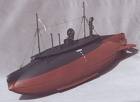|
US Navy Plunger class, the US Navy first submarine class
 In August 1900, Congress approved a contract for six improved Holland (SS-1) type submarines each to cost no more than $170K. In October 1900, a seventh submarine was approved. In August 1900, Congress approved a contract for six improved Holland (SS-1) type submarines each to cost no more than $170K. In October 1900, a seventh submarine was approved.
The Plunger class was an early class of United States Navy submarines, used primarily as training vessels for the newly formed "Silent service" to familiarize navy personnel with the performance and operations of such craft.
This class of submarines was built at two different locations on both coasts of the United States. All seven boats were renamed to A type designations (A-1 through A-7) on November 17, 1911. They were given corresponding alphanumeric hull numbers on July 17, 1920. All of the Plunger class ships were decommissioned by 1921 and used as targets.
First overseas deployment
The successful outcome of the Spanish-American War in 1898 and the subsequent acquisition of the Philippine Islands gave the United States an even greater stake in the western Pacific. Accordingly, the Navy established a major operating base and repair facility at Cavite in Manila Bay, which would serve the Asiatic Squadron until the beginning of World War II. Two of these early boats, USS Porpoise, SS-7 and USS Shark, SS-8 arrived in the Philippines in July 1908 as deck cargo on the collier USS Caesar (AC-16). This was the very first overseas deployment by US submarines. In October 1909, they were joined by USS Adder, SS-3 and USS Moccasin, SS-5, also carried across the Pacific in Caesar’s well deck, and collectively they constituted the First Submarine Division of the Asiatic Torpedo Fleet, based at Cavite and Olongapo.
Specifications, US Plunger class:
Displacement (srf/sub tons): 107/123
Dimensions (L*B*D feet/meter): 63’11*11’11*10’7/20*3.70*3.40
Propulsion: powered on the surface by a 160hp Otto Gas Engine Works gasoline engine, 150hp Electro Dynamic electric motor, 60 lead acid cells made up the storage battery; single screw 3 bladed propeller.
The engine, motor and tail shaft were connected through friction clutches to permit the motor, when driven by the gasoline engine as a generator, to recharge the battery.
Speed (srf/sub knots): 8/7
Range (srf/sub n/miles@knots): 560@6/18@4
Diving depth (feet/meter): 150/60
Complement: 1 officers 6 enlisted
Torpedo: 1*18" (450mm’) bow torpedo tube containing a total of 5 Whitehead torpedoes
Mines: none
Armament: none
Construction:
USS Plunger- A-1, Submarine Torpedo Boat No.2, SS-2
Built by: Crescent Shipyard, Elizabeth port, New Jersey
Commissioned 1903, Decommissioned 1913
USS Adder- A-2, Submarine Torpedo Boat No.3, SS-3
Built by: Crescent Shipyard, Elizabeth port, New Jersey
Commissioned 1903, Decommissioned 1919
USS Grampus- A-3, Submarine Torpedo Boat No.4, SS-4
Built by: Union Iron Works, San Francisco, California
Commissioned 1903, Decommissioned 1921
USS Moccasin- A-4, Submarine Torpedo Boat No.5, SS-5
Built by: Crescent Shipyard, Elizabeth port, New Jersey
Commissioned 1903, Decommissioned 1919
USS Pike- A-5, Submarine Torpedo Boat No.6, SS-6
Built by: Union Iron Works, San Francisco, California
Commissioned 1903, Decommissioned 1921
USS Porpoise- A-6, Submarine Torpedo Boat No.7, SS-7
Built by: Crescent Shipyard, Elizabeth port, New Jersey
Commissioned 1903, Decommissioned 1911
USS Shark- A-7, Submarine Torpedo Boat No.8, SS-8
Built by: Crescent Shipyard, Elizabeth port, New Jersey
Commissioned 1903, Decommissioned 1911
In some instances, this class of submarines is referred to as the Adder-class submarine, as the USS Adder was the first boat of the class to be completed.
Back to History Index
|